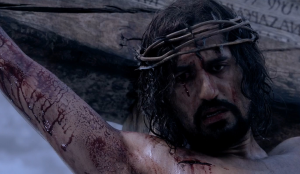
by gcadmin on Saturday, February 29th, 2020 No Comments

The Roman civilisation lasted for centuries and at one stage spanned almost all the known world. Many have studied the reasons for it’s success. No doubt the Romans were meticulous organisers and documenters, keeping detailed records at the time. Much of our current society is permeated by this influence spanning language, architecture, mythology, entertainment, government etc.
The Roman know-how was applied to torture and even to the application of the death penalty. To date, one of the most painful deaths known for a human – the Crucifixion – was perfected by the Romans. So painful was this method of execution, that a new word was required to attempt to express this ultimate pain. The word is “excruciating“.
Jesus of Nazareth was crucified 2000 years ago, innocent of any crime, he was executed for political reasons. His teachings followed by his death has resonated all over the world. With over 2 billion people following his teachings today, to say he was influential seems to fall short of the mark. The top social media celebrities and influences pale in comparison to this humble carpenter from millennia ago.
Many believe that his sacrifice was they key to life after death. This sacrifice was not a quick death, not a relatively pain-less death – but the most painful death possible at the hands of the Exactor Mortis.
The Exactor Mortis is the senior Roman soldier responsible for managing the torture or execution of human. Four soldiers follow his orders to exact and deliver the required toll – pain and/or death.
The initial verberatio, a flogging at the scourging pole, is delivered by two legionaries.
Each legionnaire is equipped with a wooden handled flagrum from which extends three leather tendrils about 3 feet in length. The tendrils can be tipped with metal or sheep bone to inflict extreme damage typically resulting in a rapid death. For Jesus however, Pilate is attempting to appease the Sanhedrin with brutal beating and perhaps thus avoiding an execution. To this end, the tendrils are tipped with lead weights calls plumbatae. These dumbbell shaped weights inflict painful deep tissue damage – brutal and extending the pain – no quick death for this Nazarene.
Jesus feels the lash. There is no gap between the blows. The instant one executioner pulls back his whip, the other unfurls his lash across Jesus’s back. Even when the tendrils of leather and lead get tangled, the soldiers don’t stop. The most lashes a man can receive under the laws of Moses are “forty minus one,” but the Romans don’t always trifle with Jewish legalities.
The instructions are to scourge the Nazarene, but under no circumstances is he to be killed.
His back is lacerated with lash marks extending down his back to the calves. In the early stages of shock, Jesus is extremely thirsty and is likely in the early stages of shock.
The Exactor Mortis and his squad have performed their duty well – surgical application so that Jesus has been beaten to near death. Pilate’s initial punishment, attempting to appease the Sanhedrin, has been completed.
However, the Jewish leaders demand their execution. Pilate accedes to their demands and Jesus is now sentenced to crucifixion.
Jesus must now carry his cross to his death. His vision is blurry, blood and sweat dripping from the crown of thorns which he now wears. He struggles to breath – his lungs surrounded by fluid. His thirst unimaginable – not having drunk anything since the day before. Jesus steps are weak, and the Exactor Mortis allows some assistance to carry the cross. If the Nazarene dies before reaching the top of Golgotha, the place for the crucifixion, the Exactor Mortis will be held responsible.
The death takes control at Golgotha.
He is forced to lie on the ground, laying atop the upper crossbeam – the patibulum. After stretching his arms, two soldiers put their weight on the arms while another uses a mallet and six-inch square iron nail, driven through the wrists to hold his arms in place.
Jesus would have cried out in pain as the nail is driven and pierces one wrist, and then the other.
The soldiers then hold up the crossbeam while a third would steady Jesus as he is backed towards the vertical beam. The death squad is aware he must die before the Sabbath – the following day – so there is no seat (sedile) on the cross which would prolong the death.
Jesus is hoisted, three soldiers holding him and the cross beam, while the fourth executioner stands on the ladder leaning against the staticulum.
Jesus’s knees are bent as a nail is pounded through his metatarsal bones – surprisingly none of them break which is very rare in a crucifixion.
 After almost three hours of agony, Jesus gazes on Jerusalem and says “It is finished”.
After almost three hours of agony, Jesus gazes on Jerusalem and says “It is finished”.
His head bows, the crown hangs down and Jesus is now unconscious. This body is slumped forward away from the cross, his arms stretched backwards with only the nails holding him in place.
The human that has lived a human life for 36 years, laughed, slept, ran, danced, cried, lived with family, talked with friends, assembled loyal apostles, preached peace and taught wisdom, the humble carpenter has stopped breathing. Jesus of Nazareth is dead.
I’ve heard sacrifice explained recently – more clearly than I’ve understood it before.
Sacrifice is giving up something for some purpose, future purpose. Sacrifice is not eating all the grain for the current year, even though you or the family might be starving so that in the next season you will have grain to plant. Sacrifice can be going to work at unpleasant and perhaps dangerous jobs so that your family can survive and prosper. Sacrifice can be fighting true evil and malevolence so that your family, community and country might continue.
Sacrifice, even at its most selfish form, is giving up something now for your future self.
This future self could be tomorrow, next month or next year. It could be for you, your family or community. Like studying now so that in a few years you can support yourself and family.
Jesus’s sacrifice was the ultimate sacrifice, in ultimate agony for the future of all humans – A sacrifice for the future of all humanity.
If you believe Jesus was simply a historical human, then his sacrifice was extraordinary. Let me put that fully – His sacrifice was extra ordinary. Jesus, his teachings and later his terrible death has benefited all of humanity.
However, if you believe Jesus was the messiah, then his sacrifice was absolutely unbelievable and driven by his love for us – A transcendent and miraculous sacrifice from none other than the son of God.
Jesus died today a long time ago – for you.
#BeGrateful #Gratitude #Gravitas
#philosophy #wisdom #meaning #responsibility #bible #inspiration #motivation
#easter #blessings #jesus
Posted in Jesus, Philosophy, Religion.